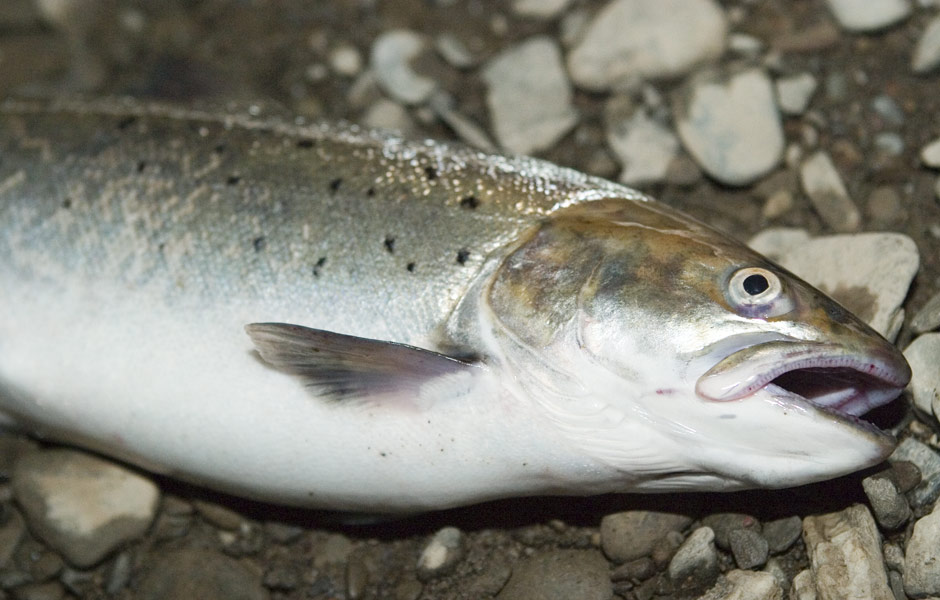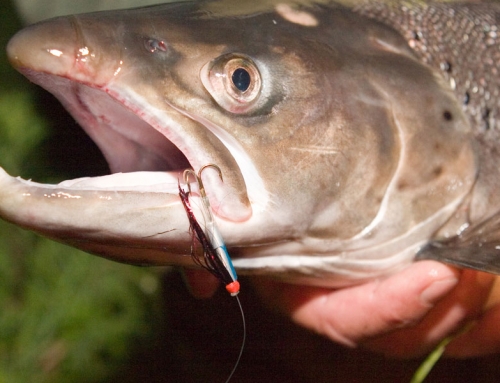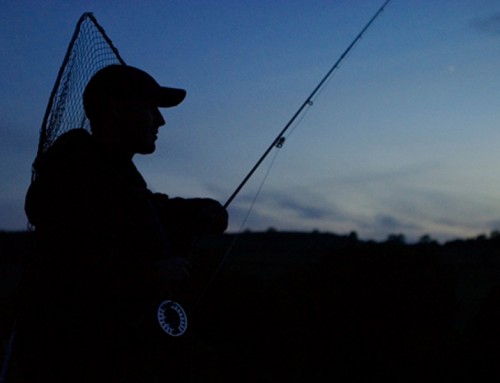Lyn Davies offers some no-nonsense advice for newcomers to sewin fishing.
Some of the most successful sewin anglers I know are somewhat narrow-minded. They wouldn’t dream of a day’s brown trout fishing, or a visit to a local fishery for rainbows – they are specialists in their field. Night fly-fishing is all they know, and they use the same methods and techniques demonstrated by their fathers and grandfathers. In comparison to many other forms of fly-fishing, night fishing for sewin is surprisingly simple.
I’m fortunate to live just a 5-minute drive away from my home water, the River Loughor in Southwest Wales. During the season, my sewin tackle is permanently set aside under the stairs for easy access. With the minimum of fuss, I can load-up my car with a checklist in my mind – rod, waders, coat, bag, net…
My Simms wading jacket carries the essentials. The left-hand chest pocket holds my fishing licences, a spare spool for my reel (loaded with a floating fly line) and a torch. The right-hand pocket is home for a small tube fly box, along with a spool of 10lb Maxima clear. My mobile is stored safely in my inner fleece jacket pocket. That’s it, no other accessories or luxuries are required. Even though wading jackets are short, I still tuck mine into my chest waders to stop it getting wet. I regularly find myself on tiptoes trying to reach that un-fished stretch of water. Waders take a hammering at night, so think cheap for night fishing, just make sure that they have cleated soles for extra grip on muddy banks. I believe that it’s best to invest in a budget pair of ‘chesties’ that will last you a season or so, and save your expensive waders for daytime fishing. A baseball cap keeps my head warm but more importantly it keeps away any rain. Although modern hoods are well designed, I find them too restrictive by a lack of peripheral vision.
My torch is only used when it’s absolutely necessary. Torches take away the mystery of the night, inform others of your presence and play havoc with your night vision. I think anglers rely on them too much, especially newbies. Try holding a tangle up to the night sky, you’ll be surprised how much you can see. This will save you time leaving the water and putting on your torch. I’m fortunate to have pretty good vision but I do sympathise with the anglers who struggle with their eyesight. I often tie flies on for my more elderly fishing companions.
A large and more importantly, light net is essential. Mine is permanently erected and slung over my shoulder with a quick release buckle (available from camping shops). It’s quick to hand and is out of the way from barbed-wire fences and bank side vegetation. I’ve also added some lead weight to the bottom of the handle to help keep it upright. There’s nothing worse than a net swivelling around your back when you are trying to concentrate on fishing. If I carry a bag, I prefer the game type used by shooting enthusiasts. It’s large and soft enough to wrap around your body out of the way, you don’t know it’s there.
My old faithful 10ft, 8-wt Sage RPL fly rod serves me well for night fishing. It has the backbone to cast large lures and can deal with a feisty double-figure fish. Attached to it is a battered Scierra IC3 fly reel, which has never let me down. This lightweight, large arbour cassette reel again does the job. However careful you are, there are times (usually following the excitement of landing a fish) that your reel is thrown onto sand, mud, or gravel. I suggest leaving your expensive kit at home, it will get a lot of abuse at night. Loaded onto the IC3 is a fail-safe, Cortland Blue Intermediate, WF7. Some anglers prefer a floating line but I think an intermediate is the best all-rounder for the night. I’m only casting short distances (usually just a simple pick up and lay down), so I don’t waste money on expensive lines. I carry a floater, but it’s rarely used. I’m usually too lazy to even change lines to fish the Surface Lure – there’s rarely enough line on the water to drag the lure under.
I began my sewin fishing career using large, streamlined singles tied on low water salmon hooks but over time small aluminium tubes have won me over. Their added weight gets me amongst the fish quickly, with the minimum of fuss. They are easy to tie, harder wearing and of course the trebles can be replaced easily. If a single hook fly is damaged it must be binned. We all lose fish but overall, my favoured size 12 Kamasan B990’s have served me well – they are pin sharp and don’t cost the earth. The only downside of a treble is that they tend to pick up more debris and catch in your net.
Leaders are exposed to all sorts of abuse at night, so I opt for a relatively heavy nylon as opposed to more expensive flurocarbon. My tried and tested 10lb Maxima clear has never let me down and always keep your leader short – between 6 and 8ft. Short leaders are easier to manage and help turnover heavy flies when casting into awkward places, where the fish tend to lie. I wouldn’t recommend using anything less than 10lb breaking strain either. Thinner diameter leaders are more subject to kinks, tangles and wind knots. I’m convinced that using a heavier nylon doesn’t make the least bit of difference to the fish. I avoid droppers at night, extra flies have the potential to catch in snags, encourage tangles, and hook up in the net while landing fish.
Ninety-nine percent of my fishing involves wading, it’s a luxury to fish from a shingle or grass bank at night. Wading spate rivers can be hard work, you’re often fishing around submerged trees and other obstacles including car tyres and even shopping trolleys! If you are in the water, it’s important to be quiet, stealth like and simply take your time – wade like a heron. As ever, I always recommend a daytime reconnaissance, not only for safety reasons but to understand where the fish could be lying. As a rule, I fish down and across using a slow figure of eight retrieve. I try to cast as square as possible (at times using an upstream mend), to cover more water and to help encourage my fly to fish as deep as possible. I always aim to position my fly as tight as possible to the opposite bank. Following the fly round in an arc, I raise the rod – which in turn makes the fly fish faster. Fish will follow you, so it’s always worth holding or hanging the fly directly downstream before a recast. With as much line out as possible, one false cast and I’m fishing again. I remember my father once telling me, “You won’t catch fish in the air!”.
I never spend too long flogging one spot, even if it’s a known hot spot. Generally, if a fish is going to take, it’ll happen quite soon but there are of course exceptions. Keep mobile, I’m a great believer in fishing as many places as possible. Fortunately, at night your sense of hearing and feeling are very much accentuated. At times, something just feels wrong whether it’s a tangle or you’ve picked up some weed on your fly. Even if I know I haven’t caught the opposite bank or clipped a tree, I always take the time to periodically check my fly for debris and ensure that the treble is still pin-sharp and sitting correctly in place. If a point is blunt or bent, stop, and replace it immediately. It will only play on your mind, and if you lose that fish…
If you put the time in, you will reap the rewards. You’ll feel that pull, as everything tightens up and a sewin immediately thrashes about on the surface in a bid for freedom. So many fish are lost at this point, especially big ones. Inexperienced anglers tend to panic, holding a tight line hoping that the fish will eventually calm down. This is a mistake. From experience, you must remember to drop the rod or release some line, allowing the fish time to drop its head and turn away. When this happens, it’s usually well hooked. Next, reel in any slack line to play the fish off the reel. Sewin will perform some mad, unexpected runs – so always be prepared. Be aware of your surroundings – if necessary, re-position yourself to make it as easy as possible to land a fish. Preferably, this needs to be away from any hazards, including fast currents and submerged branches. Try to move the fish upstream, away from any water you haven’t yet fished, there may well be another one and the same place. Use your rod to tire the fish and always maintain a tight line, don’t make a meal of the fight, especially if you intend to return the fish. You’ll be surprised how quickly you can land a sewin at night. Once you’re through the initial mayhem, even a double-figure fish can sometimes be netted in minutes – depending on where you are in the river. Most of my fish are netted prematurely before I see the underside of their bellies. Get it right and it’s possible to scoop fish into your net earlier than expected, which is always a good thing.
Once in the net, it’s a case of retreating to either shallower water or the nearest bank to unhook the fish – try and be swift and always keep the fish wet. Unfortunately, trebles can cause some damage to the inside of the mouth. Depending on where the fish is hooked, it can prove difficult to retrieve small trebles too. Compared to a longer single hook fly, trebles have a lot less leverage and tend to cling on to flesh. It’s always interesting to see where fish are hooked and it’s surprising how often you them very lightly hooked, leaving the treble tangled in the net. All my fish are returned these days, so whenever possible, I remain in the river. This proves less stressful for the fish, makes less disturbance to the pool and enables you to continue fishing quicker. Following a check of my leader and alignment of the tube, I’m ready to go again.
There’s a lot of mystery surrounding night fishing for sewin, which is no doubt one of the main attractions. Don’t be put off by the unknown, it may not be for everyone but if it’s something you’ve read about and always wanted experience – just get out there and give it a try. As I’ve said, the techniques are simple, it’s just that you’re in the dark and this only becomes easier with experience. Yes, it’s hard work and you may struggle to begin with, but it’ll all be worth it when you feel that first heavy pull from this most enigmatic of fish.





Hi I’m a keen fly fisherman of trout & grayling, this year will be my first year fishing for seeing, I have read your fishing guide & found it very useful, simon
Hi Simon – thanks for the feedback. Glad you liked the article. Tight lines!
Fished 42 years on both Eastern and Western Cleaddau in West Wales and can relate very much to all you say here Lyn. Undoubtedly the experience of hooking a wild sea trout at night on fly is the ultimate fly fishing experience. Sadly sea trout numbers are in decline but we fish on! Great advice here in your article.